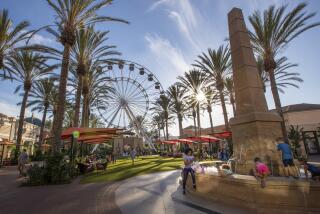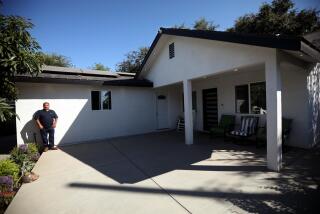Westchester Area Gets Denser, Census Shows : Growth: Apartments replace houses and gas stations. Population is up 10% since 1980, and dwelling units are up 23%.
- Share via
In the five years that he has shepherded schoolchildren across his busy intersection on Manchester Avenue, crossing guard Louis Gruca Sr. has seen apartment houses replace two of the gas stations that once occupied all four corners.
A third filling station at the intersection closed down three months ago, and apartments also may take its place.
This intersection represents a microcosm of Westchester and Playa del Rey, where a startling 23% growth in the number of dwelling units since 1980, revealed in the 1990 Census, shows how the number of apartments and condos have risen.
In one census tract alone, north of Los Angeles International Airport and west of Lincoln Boulevard, census takers last year found 4,950 units, a 76% increase from 1980.
The neighboring tract, which includes a development of upscale homes that spill down the bluffs overlooking the Ballona Wetlands, had a 33% increase in total units, some of them for sale for as much as $1.8 million.
In the entire Westchester area, the ratio of people to dwellings dropped from 2.4 to 2.1, according to preliminary data released by the Census Bureau.
“The place is changing,” said Gruca, a retired meat cutter who originally came from Chicago and has lived in Westchester for 25 years. “Too many accidents. Too many people. If I came out here today with my wife and kids, we’d never make it. It takes two people just to pay the rent.”
Indeed, the rents are hardly cheap at the apartment buildings that have sprung up like mushrooms after a rain along Manchester Boulevard.
Two-bedroom apartments can go for $1,350 a month, and houses are hardly a bargain either, with most being offered at $300,000 and up--”beyond our wildest dreams,” in the words of Shirley Pfeil, a resident for 44 years, who can remember when houses cost less than 10% of that.
In Westchester, a suburb that once teemed with children--residents of one block on Naylor Avenue counted 62 youngsters in the early 1950s--the number of children dropped by 6% from 1980, the census found.
The number of adults grew by 13%, however, raising the total population by 10% to 47,498 people on April 1, 1990.
There are so many new people that the Los Angeles Department of Water and Power is tripling the capacity of its distributing station on Gulana Avenue, a facility that has relayed electrical power to homes in the area since Westchester was first developed in 1940.
“What we’ve been doing in the past year is putting in pole-top transformers to serve the growing demand, but eventually those are not as reliable, and we need to upgrade the distributing station,” said Mindy Berman, a spokesman for the DWP.
The city is also extending Westchester Parkway from Sepulveda Boulevard to Playa del Rey, a project that would funnel traffic to the proposed Northwide business park and commercial center adjoining the airport.
It was not always thus. After a period of rapid growth in the 1940s and ‘50s, Westchester lost 3,500 homes and 10,000 people when streets were vacated to make way for airport expansion in the 1970s.
But location always triumphs in real estate, and Westchester, caressed by sea breezes, cooled by mists and close to the freeway, proved irresistible to developers, renters and condo buyers in the 1980s. Streets of small rental houses gave way to apartment complexes with eight to 10 units each.
“There were duplexes and singles that backed up to Manchester, and whenever any of them hit the market, someone tore it down” to build apartments, said Carol Baer, a resident for 35 years, who grew up in Westchester.
She remembers swimming in the ocean when the ocean was cleaner, and playing in fields full of wildflowers where million-dollar houses now enjoy a bluff-side view of much of the Westside.
Now aquatics director at the Westchester Family YMCA, Baer said the Y is feeling the impact of the latest population growth.
“We’re growing, and probably faster with adults than with younger children,” she said. “And with most of the parents working, we have a greater demand in the early evenings and weekends.”
With the prospect of major commercial and office developments to the north, east and south, Westchester may experience even more growth in the 1990s, some residents fear.
“We’re going to be concrete from one end to the other,” Baer said.
But Gary Heligman, manager of the Remax Beach Cities Realty office, said the frenzy of construction may have saturated the housing market, at least for now.
“We’re looking at (rental) prices in some cases $100 to $200 (a month) under what they would have rented for a year or two ago,” he said. “All of a sudden there’s an oversupply and a fairly steady demand, so until that’s filled, it’s going to stay soft.”
Some future growth may be internal. Despite the drop in the number of children between 1980 and 1990, a second-generation baby boom has started to be felt in the last few years.
“During our Sunday morning Sunday school, we used to have a maximum of four children, but now we have anywhere from 12 to 18,” said Georgiann Young, secretary of the Westchester Lutheran Church and School.
“We lose older members to either moves or deaths, and we had younger members come in to replace them,” she said.
Young, a Palms resident, said she feels at home in Westchester because of its small-town feeling.
“When you see people on the street here, they’ll wave at you, and where I live, that’s missing,” she said.
Although Westchester has become more integrated in the last decade, it remains predominantly white. White residents make up 72% of Westchester’s population, down from 82% in 1980; 12% are Latino, up from 10%, 7% are black, up from 3%, and 8% are Asian, up from 4%.
A Decade of Growth in Westchester-Playa del Rey
A building boom in the ‘80s brought a 23% increase in the number of housing units and a 10% population gain to the Westchester-Playa del Rey area in the ‘80s, according to Census data. Much of the growth was concentrated in two sections of Playa del Rey. In Tract 2766.02, the Westchester High School neighborhood, had a large jump in apartment and condominium construction. Just to the north, Tract 2766.01 was an area in which many new large homes were built, including the mansions that seem to cascade down the Westchester Bluffs.
Area ’90 Population % chg Dwellings % chg from ’80 from ’80 Westchester-Playa del Rey 47,948 10 22,572 23 Tract 2766.01 3,403 19 1,543 33 Tract 2766.02 7,528 40 4,950 76
More to Read
Sign up for Essential California
The most important California stories and recommendations in your inbox every morning.
You may occasionally receive promotional content from the Los Angeles Times.










